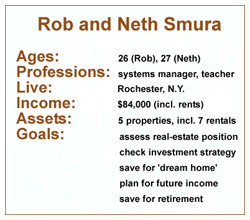|
Real estate benefits techie
|
 |
August 7, 2000: 10:23 a.m. ET
A computer-systems manager and ex-Marine loves housing deductions
By Staff Writer Alex Frew McMillan
|
NEW YORK (CNNfn) - Rather than college, Rob Smura went into the Marines. He started as a small-arms repairman. "I was fixing M-16s, 9mms, .45s, anything up to sniper rifles and chain guns," he said. "It's really interesting if you're into guns."
He has a fascination with them, he admits. Smura, now 26, got to travel to Japan for six months, too, after basic training at Parris Island, S.C.
 But before weapons, came computers. His fourth-grade teacher had turned him on to those. "I thank her for introducing me to computers," he said. "It's the best thing that ever happened to me." But before weapons, came computers. His fourth-grade teacher had turned him on to those. "I thank her for introducing me to computers," he said. "It's the best thing that ever happened to me."
So after two years with the Few and the Proud, government cutbacks offered him an early out of his six-year enlistment. He returned to Rochester, N.Y., where he went to high school, and looked for information-systems jobs.
Donald Trump, here I come
Two jobs later, including a stint in information technology at Eastman Kodak (EK: Research, Estimates), he makes $55,000 a year as an information-systems manager at a local packaging company. He has been earning around 8.5 percent a year in bonuses too.
Smura bought his first house when he moved back home. A real estate agent friend hooked him up with a deal on a double in downtown Rochester. Smura moved in and rented out the other half.
 He liked that he only ended up paying $115 a month on his mortgage, with the tenant covering the rest. Next his neighbor wanted to sell, and Smura got a good deal because, he said, central Rochester isn't the best of neighborhoods. He liked that he only ended up paying $115 a month on his mortgage, with the tenant covering the rest. Next his neighbor wanted to sell, and Smura got a good deal because, he said, central Rochester isn't the best of neighborhoods.
Now he's got into the habit of closing on a house every year.
"I'm not so worried about the sale price in the end," he said. "What matters is that I make money on the rent."
And, ah the bliss of the deductions. With the ability to deduct $6,000 to $8,000 in closing costs per home, and any improvements and depreciation, he said he got almost $4,000 back on his taxes last year.
He has since moved to a better area. He now owns five properties, giving him seven rental units and the house he lives in. He is looking at a couple of small apartment buildings to buy.
The rents net him around $600 a month, he calculates, given expenses and tenant turnover.
Checks & Balances runs weekly on CNNfn.com. People with questions about financial planning are invited to write in explaining their financial picture and short- and long-term goals. See the bottom of this article for specifics. For those selected, financial planners will review the details and suggest ways to meet those goals.
Smura got married two months ago, to Neth, 27. She's a substitute teacher who is studying for her certificate in special education. She makes around $18,000, but that should close to double once she's certified.
 Neth was born in Laos but moved to the United States as a child. They met in high school, and their romance blossomed after they ran into each other for work. Neth was born in Laos but moved to the United States as a child. They met in high school, and their romance blossomed after they ran into each other for work.
They haven't had time for their honeymoon. Smura has an expensive hobby, studying for his pilot's license, which makes it tough to save for the trip.
"I think entertainment is a necessity," he explains, "and spend whatever I think we are able for my wife and I to have some fun. It varies."
He's not wanton, though. After their marriage, Rob Smura took out $150,000 in life insurance coverage -- on top of $100,000 at work. Should he die, his wife would be able to pay off most of his mortgages. She could keep renting the properties, or just sell if she didn't want to deal with them.
Smura puts 15 percent of his salary into his 401(k), with a match of just over 50 percent. He splits it between the RS Emerging Growth fund (RSEGX) and the Janus Worldwide fund (JAWWX). The balance is a bit beyond $20,000.
"Both of these funds have been dropping lately, but I am in it for the long haul," he wrote.
Working toward the job he wants
He divides $2,000 a year between a Roth and traditional IRA. Each month he plunks $300 into an S&P 500-tracking fund, money toward buying his "dream house." That, he imagines, will cost $250,000 to $300,000, in the next six years or so.
In all, Smura, who was born in Colorado, where his dad was an airman at the Air Force academy, has built a nest egg of around $13,000 toward retirement in the IRAs. If he retires early, and can't get his hands on his retirement accounts without penalties, he figures he'll have the properties to fall back on.
He'll work the rest of his life, he thinks. But he wants to pick his job. "I don't want to have to work," he states. A couple of kids also might be in the future for the young couple, he speculates.
"What else could I be doing? Am I doing enough? Should I be doing something different?"
What the planners say:
"You certainly should be complimented on how much you have accomplished in such a short period of time," said Roy Diliberto, a certified financial planner in Philadelphia. He is president of RTD Financial Advisors there and also president of the Financial Planning Association.
Smura seems to understand stock-market volatility, Diliberto added, and is doing more than just trying to save what's left over after the bills. In fact, Diliberto jokes, he seems to have learned the secret of financial security -- "you pay yourself first."
That said, there is room for improvement. The first issue that leaps out at Diliberto is that tax losses on property start phasing out when your adjusted gross income rises beyond $100,000. Once Neth starts working full time, and if Rob Smura's income rises, he will start bumping that limit.
 A tandem issue, the planner explains, is to do a comparison analysis when buying property. A tandem issue, the planner explains, is to do a comparison analysis when buying property.
"Would an alternate investment be more suitable?" Diliberto asks. Not only may the tax write-offs be less attractive on further real estate, but it is illiquid and requires direct management.
For property, "you should expect a higher total return than you would expect from a mutual fund," Diliberto said. With the S&P 500 gaining around 11 percent a year, historically, you should make sure you return at least 2 percent above that on your property, according to the planner. Otherwise the investment isn't worthwhile, given the options.
How does property management strike them?
Phil Cook, a certified financial planner in Los Angeles, also has some thoughts about Smura's brick holdings. Yes, in retirement, your income rises with your rents. But a few more purchases, and the Smuras will either have to quit their jobs to become full-time property managers -- and forsake good salaries -- or hire a management company.
And while property normally increases in value, there have been several real estate recessions, sometimes prolonged, Cook points out. That makes housing a little less attractive. Quitting their jobs and becoming serious property managers could meet Smura's goal of picking his job and making a little less, if he's into that, the planner admits.
The Smuras also have a bit of credit-card debt, around $1,000. Unless they're getting a break on intro "teaser" rates on the plastic, Cook instructs them to ditch that debt right away, instead of looking to pay off more than their mortgage minimums.
Smura's mortgage on his home is at 7 percent, but most credit card debt runs 18 percent to 21 percent, Cook points out. As a budgeting issue going forward, "don't charge it if you can't pay the entire balance due at the end of the month," Cook says.
Click here to read last week's Portfolio Rx, a column that runs every Tuesday in CNNfn's Retirement section. Each article reviews an investor's long-term portfolio, using financial experts to offer advice.
Roth Roth the boat, tax free is a dream
Both the planners figure Smura is in or around the 15 percent federal tax bracket, after deductions. So they agree he should bag his idea of splitting his IRA contributions between a Roth IRA and a regular IRA.
Why? The regular IRA generates an instant tax write-off, sure, and the planners figure that's why Smura is attracted to it. But the balance is ultimately taxable when it's withdrawn. The Roth IRA contributions provide no benefit now, but Smura is already getting a tax refund now.
The Roth money will, though, be tax free when he takes it out. So they tell him to pay the full $2,000 into the Roth IRA now, while he can. "It's reasonable to assume their tax bracket won't ever be lower than it is now," Cook said.
Diliberto adds that Smura might even want to consider converting his existing IRA into a Roth. He would have to watch that the conversion doesn't bump him into another tax bracket. But it might still be worthwhile, again because Smura is likely in the lowest tax bracket of his life. Diliberto also encourages Neth to start putting $2,000 a year in a Roth IRA, for the same reasons.
Making the 'dream house' a reality
The "dream house" that Smura envisions buying in about six years already needs a little work now, according to the planners. To make a 20 percent down payment, the planners both say that Smura should be setting aside more than double the $300 a month he is putting into the S&P tracking fund.
He has two options if that's impossible. One is to put down only 10 percent on the house, which then will require private mortgage insurance. So it's best to put down more than 20 percent if possible, Cook said. The other is to count on cash from selling their current home, which they're already counting on to some degree.
Buying the dream house should be manageable, the planners think. But Diliberto cautions them not to get too carried away. For instance, Smura might want to think about breaking some of the mutual fund money he's setting aside into a bond fund, the planner said. That reduces risk. The six-year horizon will come up quickly.
"The last thing you want to do is be forced to sell during a major correction to buy that house," Diliberto said. By extension, the same could be said of their "investment" in their current home, which could also require them to sell at a bad time if it's value is in a downturn in six years.
A rebalancing act
The planners had a tricky time coming up with any concrete projections on Smura's retirement and how much he should save. There are too many variables, Cook and Diliberto agreed, because Smura's career and age of retirement aren't fixed.
But Cook encourages him to keep plugging away at whatever 401(k) options -- or similar plans -- come his way at future employers.
Given that the money is for retirement, Diliberto encourages Smura to rebalance a little. The growth funds in his 401(k) are fine, but suffer in downturns like, so far, in 2000.
Keep 55 percent split between his existing RS Emerging Growth and Janus Worldwide funds, Diliberto added. But reallocate 20 percent in the Janus Mercury fund (JAMRX) and 25 percent in the Weitz Value fund (WVALX).
That should give him a bit more small-cap and value exposure, Diliberto said. Both are available to Smura in his plan.
"I want to commend you on the discipline you have shown," Diliberto concluded. "You will be rewarded, I am confident, with the achievement of financial security at a young age."
* Disclaimer
Got questions about financial planning? Need some advice? CNNfn.com has organized a panel of outside experts to answer your questions. If you want to be considered for the "Checks & Balances" column, where professional planners suggest ways you can manage your money, send us an e-mail at checksandbalances@cnnfn.com. Include information about your age, occupation, income, assets and monthly expenses -- imagine you're providing a full income statement and balance sheet. Also, share with us any short-term and long-term financial goals you may have. And don't forget to leave your phone number. 
|
|
|
|
|
 |

|

